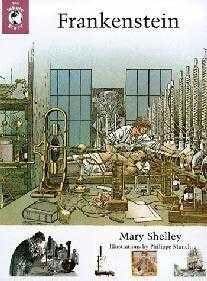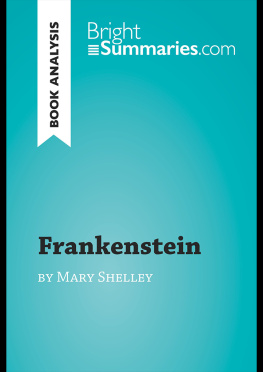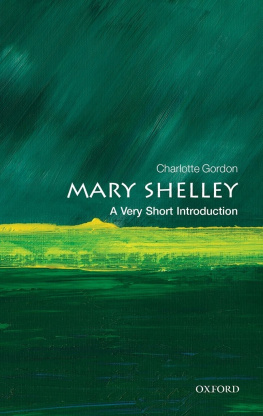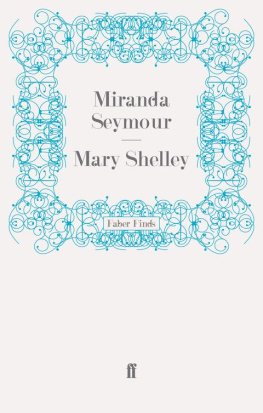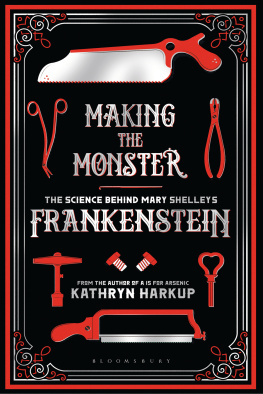Mary Shelley and the Rights of the Child
Mary Shelley and the Rights of the Child
Political Philosophy in Frankenstein

Eileen Hunt Botting

Haney Foundation Series
A volume in the Haney Foundation Series, established in 1961
with the generous support of Dr. John Louis Haney.
Copyright 2018 University of Pennsylvania Press
All rights reserved. Except for brief quotations used for
purposes of review or scholarly citation, none of this book
may be reproduced in any form by any means without written
permission from the publisher.
Published by
University of Pennsylvania Press
Philadelphia, Pennsylvania 19104-4112
www.upenn.edu/pennpress
Printed in the United States of America on acid-free paper
10 9 8 7 6 5 4 3 2 1
Library of Congress Cataloging-in-Publication Data
Names: Botting, Eileen Hunt, 1971 author.
Title: Mary Shelley and the rights of the child : political
philosophy in Frankenstein / Eileen Hunt Botting.
Other titles: Haney Foundation series.
Description: 1st edition. | Philadelphia : University of
Pennsylvania Press, [2017] | Series: Haney Foundation series
Identifiers: LCCN 2017012493 | ISBN 9780812249620
(hardcover : alk. paper)
Subjects: LCSH: Shelley, Mary Wollstonecraft, 17971851.
Frankenstein. | Shelley, Mary Wollstonecraft, 17971851
Political and social views. | Childrens rightsPhilosophy. |
Childrens rights in literature. | Parent and child in literature.
Classification: LCC PR5397.F73 B676 2017 | DDC 823/.7dc23
LC record available at https://lccn.loc.gov/2017012493
CONTENTS
Growing up in suburban Massachusetts in the 1970s, I spent my Saturday afternoons, like most kids in the Boston area, watching the Creature Double Feature on Channel 56. The double feature consisted of two monster moviesusually beloved B-movies made by Universal Studios of Hollywood, Hammer Studios of London, and Toho Studios of Tokyo from the 1930s through the 1960s. In the matinee lineup, there was typically a giant monster movie, such as Mothra vs. Godzilla, paired with a small monster movie, such as Frankenstein Meets the Wolf Man. Battles between monsters (usually of the same size) were common, but these battles derived their interest from the original Universal monster movies of the 1930s, which centered on a single creature of supranatural (and typically malevolent) powers.
In this mnage, Dracula, the Wolf Man, and Frankensteins Creature loomed large in my imagination. They were the archetypal monsters from which all other monsters were madethough small compared to Godzilla and the radiation-spawned mutants of the Pacific Rim. The Japanese giant monster movies, in fact, all seemed to mine from the core theme of the Frankenstein story: humans could use the power of science to create or alter life irresponsibly, thus causing their own destruction. In the aftermath of Hiroshima, this lesson from fiction felt all too real.
To my childhood self, however, Dracula was the scariest monster by far. The Count appeared human yet used his supernatural powers to deliberately and emotionlessly do inhuman things to his vulnerable human victims, who were usually young women. By contrast, werewolves were frightening if only because a completely innocent person could become one by chance, as when bitten by a wolf in the middle of the night. After that stroke of bad luck, all it took was the light of the full moon to trigger ones transformation into a bloodthirsty animal ruled by instinct. Dracula was scary for his intentions, but the Wolf Man was frightening for his lack of them.
The real puzzle to my young mind was why Frankensteins Creature was even considered a monster. The Frankenstein films were simply not scary in the way that the blood-soaked vampire and werewolf flicks were. Most of the time, I could not even watch the opening credits of a Hammer Studios vampire movie without running out of the room as soon as their signature special effectTechnicolor blooddripped down the neck of a maiden victim of the Count. Unlike Dracula and the Wolf Man, Frankensteins Creature commanded a spooky fascination and awe but not horror. Although he was assembled from the parts of human and other animal corpses, then animated by electricity, his oversized, even clumsy framegrotesque as it waselicited more sympathy than fear. The Creature was not evil incarnate like Dracula, nor an animal gone haywire like the Wolf Man. The Creature was more like an orphan child, made and abandoned by his scientist father and abused by nearly everyone he encountered as he strove to survive in the world on his own.
The Universal Frankenstein films of the 1930s reinforced this view of the Creature as a child who was not born evil but rather made monstrous as a result of mistreatment. In the 1931 classic Frankenstein, directed by James Whale, the reanimated Creature first greets the light with the sensitive eyes, inarticulate sounds, and inquisitive hands of a newborn. This innocent moment is soon disturbed by his sadistic abuse at the hands of Dr. Frankensteins servant Fritz, who tortures him with a stick set on fire. Once he escapes, the Creature roams the countryside looking to satisfy the basic needs denied him by his father and Fritz: food, water, shelter, security, care, companionship, and love. He instead finds villagers who respond to him with violence due to his strange appearance. Seeking a respite from this abuse, he encounters a little girl, who has been let outside to play by her parents. In a striking cinematic image, the towering Creature and the tiny child sit together contentedly, tossing daisy petals into a sunlit pond. When the petals run out, the Creature assumes the girl, pretty like a flower, wants to be thrown into the water. Unaware that she will not float like the petals, he unintentionally causes her to drown. Horrified, the Creature runs away, as a child does when he cannot face the consequences of what he has done. In fact, the actor Boris Karloff wanted to underscore the Creatures innocence by laying the girl in the water gently like a flower, but Whale directed him to pick her up roughly and throw her in the pond. Either way, Karloff ingeniously interpreted the Creature as an affectionate and playful child who, without the guidance of a parent or any other adult, does not know
Whales 1935 sequel, The Bride of Frankenstein, manipulates the image of the Creature as a child to both comic and tragic effect. In an almost slapstick scene, the Creature proves himself to be an amiable companion to an old blind man living alone in the woods. Unafraid of his guest because he cannot see him, the hermit unwittingly spills soup on the grunting Creature but cheerfully bonds with him over shared wine and tobacco. Mmmmm good! the Creature blurts to his phwend, as a toddler would happily babble to a parent who feeds him. Some villagers stop by the cottage and disrupt this brief domestic idyll, attacking the Creature on sight. Later, the Creature learns more words under the tutelage of Dr. Pretorius. He uses the power of language to demand that his father furnish him a companion. Dr. Frankenstein makes him a bride despite his reservations about Dr. Pretoriuss plan to use the so-called monsters to create a new species. When the bride unexpectedly rejects her intended mate, the Creature does not seek revenge against his father or his wife, Elizabeth. All grown up, yet truly alone, he chooses to immolate himself, his bride, and Dr. Pretorius in the flames that consume his fathers laboratory in order to prevent further harm that they (or his fathers science) could do to others. Watching these films directed by Whale, my young self sympathized with the Creature more than anyone. As Stephen King cogently remarked, We see the horror of being a monster in the eyes of Boris Karloff.
Next page

